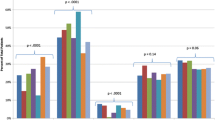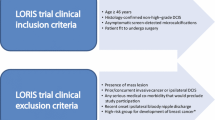Abstract
Background
Ductal carcinoma-in situ (DCIS) is a preinvasive form of breast cancer associated with excellent outcomes after either mastectomy or breast conservation therapy. Previous studies have demonstrated declining rates of mastectomy. However, it is unclear how this pattern has changed in recent years.
Methods
Women with DCIS were identified within the National Cancer Data Base. Patients treated with lumpectomy with or without radiotherapy were compared to women treated with mastectomy on the basis of demographic, clinicopathologic, and reporting facility details using χ 2 tests and multivariable logistic regression modeling to identify factors that may influence surgical choice. Changes in the proportion of women receiving contralateral prophylactic mastectomy (CPM) were assessed in a similar fashion.
Results
We identified 212,936 women diagnosed with DCIS between 1998 and 2011. Lumpectomy was performed in 68 % (144,681) of patients. Mastectomy rates initially declined from 1998 (36 %) through 2004 (28 %), before increasing again through 2011 (33 %). Younger patient age, greater medical comorbidity, more extensive disease, higher tumor grade, treatment at an academic facility, and greater distance from the reporting facility were associated with heightened use of mastectomy (all p < 0.001). CPM also increased over time, particularly among younger patients, on multivariate analysis (p < 0.001).
Conclusions
Mastectomy utilization appears to be rising between 2004 and 2011, particularly among younger patients and those with higher-risk histopathologic features. CPM is increasing in a similar fashion. Further research is needed to understand the drivers of this change.



Similar content being viewed by others
References
Ernster VL, Barclay J, Kerlikowske K, Grady D, Henderson C. Incidence of and treatment for ductal carcinoma in situ of the breast. JAMA. 1996;275:913–8.
Collins LC, Tamimi RM, Baer HJ, Connolly JL, Colditz GA, Schnitt SJ. Outcome of patients with ductal carcinoma in situ untreated after diagnostic biopsy: results from the Nurses’ Health Study. Cancer. 2005;103:1778–84.
Welch HG, Schwartz LM, Woloshin S. Ramifications of screening for breast cancer: 1 in 4 cancers detected by mammography are pseudocancers. BMJ. 2006;332(7543):727.
Eusebi V, Foschini MP, Cook MG, Berrino F, Azzopardi JG. Long-term follow-up of in situ carcinoma of the breast with special emphasis on clinging carcinoma. Semin Diagn Pathol. 1989;6:165–73.
Page DL, Dupont WD, Rogers LW, Jensen RA, Schuyler PA. Continued local recurrence of carcinoma 15–25 years after a diagnosis of low grade ductal carcinoma in situ of the breast treated only by biopsy. Cancer. 1995;76:1197–200.
Welch HG, Black WC. Using autopsy series to estimate the disease “reservoir” for ductal carcinoma in situ of the breast: how much more breast cancer can we find? Ann Intern Med. 1997;127:1023–8.
National Comprehensive Cancer Network. NCCN practice guidelines in oncology: breast cancer. Version 3.2014. http://www.nccn.org/professionals/physician_gls/pdf/breast.pdf. Accessed Sept 2014.
Wapnir IL, Dignam JJ, Fisher B, et al. Long-term outcomes of invasive ipsilateral breast tumor recurrences after lumpectomy in NSABP B-17 and B-24 randomized clinical trials for DCIS. J Natl Cancer Inst. 2011;103:478–88.
EORTC Breast Cancer Cooperative Group; EORTC Radiotherapy Group; Bijker N, Meijnen P, Peterse JL, et al. Breast-conserving treatment with or without radiotherapy in ductal carcinoma-in situ: ten-year results of European Organisation for Research and Treatment of Cancer randomized phase III trial 10853—a study by the EORTC Breast Cancer Cooperative Group and EORTC Radiotherapy Group. J Clin Oncol. 2006;24:3381–7.
Holmberg L, Garmo H, Granstrand B, et al. Absolute risk reductions for local recurrence after postoperative radiotherapy after sector resection for ductal carcinoma in situ of the breast. J Clin Oncol. 2008;26:1247–52.
Houghton J, George WD, Cuzick J, et al. Radiotherapy and tamoxifen in women with completely excised ductal carcinoma in situ of the breast in the UK, Australia, and New Zealand: randomised controlled trial. Lancet. 2003;362(9378):95–102.
Zujewski JA, Harlan LC, Morrell DM, Stevens JL. Ductal carcinoma in situ: trends in treatment over time in the US. Breast Cancer Res Treat. 2011;127:251–7.
Baxter NN, Virnig BA, Durham SB, Tuttle TM. Trends in the treatment of ductal carcinoma in situ of the breast. J Natl Cancer Inst. 2004;96:443–8.
Punglia RS, Schnitt SJ, Weeks JC. Treatment of ductal carcinoma in situ after excision: would a prophylactic paradigm be more appropriate? J Natl Cancer Inst. 2013;105:1527–33.
Evans D, Barwell J, Eccles D, et al. The Angelina Jolie effect: how high celebrity profile can have a major impact on provision of cancer related services. Breast Cancer Res. 2014;16:1–6.
Balch CM, Jacobs LK. Mastectomies on the rise for breast cancer: “the tide is changing.” Ann Surg Oncol. 2009;16:2669–72.
Rutter CE, Chagpar AB, Evans SB. Breast cancer laterality does not influence survival in a large modern cohort: implications for radiation-related cardiac mortality. Int J Radiat Oncol Biol Phys. 2014;90:329–34.
Piot-Ziegler C, Sassi ML, Raffoul W, Delaloye JF. Mastectomy, body deconstruction, and impact on identity: a qualitative study. Br J Health Psychol. 2010;15(Pt 3):479–510.
Polsky D, Mandelblatt JS, Weeks JC, et al. Economic evaluation of breast cancer treatment: considering the value of patient choice. J Clin Oncol. 2003;21:1139–46.
Palit TK, Miltenburg DM, Brunicardi FC. Cost analysis of breast conservation surgery compared with modified radical mastectomy with and without reconstruction. Am J Surg. 2000;179:441–5.
Montgomery LL, Tran KN, Heelan MC, et al. Issues of regret in women with contralateral prophylactic mastectomies. Ann Surg Oncol. 1999;6:546–52.
Goldflam K, Hunt KK, Gershenwald JE, et al. Contralateral prophylactic mastectomy. Predictors of significant histologic findings. Cancer. 2004;101:1977–86.
McGuire KP, Santillan AA, Kaur P, et al. Are mastectomies on the rise? A 13-year trend analysis of the selection of mastectomy versus breast conservation therapy in 5865 patients. Ann Surg Oncol. 2009;16:2682–90.
Levy DE, Byfield SD, Comstock CB, et al. Underutilization of BRCA1/2 testing to guide breast cancer treatment: black and Hispanic women particularly at risk. Genet Med. 2011;13:349–55.
Elsayegh N, Kuerer HM, Lin H, et al. Predictors that influence contralateral prophylactic mastectomy election among women with ductal carcinoma in situ who were evaluated for BRCA genetic testing. Ann Surg Oncol. 2014;21:3466–72.
Tuttle TM, Jarosek S, Habermann EB, et al. Increasing rates of contralateral prophylactic mastectomy among patients with ductal carcinoma in situ. J Clin Oncol. 2009;27:1362–7.
Sue GR, Lannin DR, Au AF, Narayan D, Chagpar AB. Factors associated with decision to pursue mastectomy and breast reconstruction for treatment of ductal carcinoma in situ of the breast. Am J Surg. 2013;206:682–5.
Cutuli B, Lemanski C, Fourquet A, et al. Breast-conserving surgery with or without radiotherapy vs mastectomy for ductal carcinoma in situ: French Survey experience. Br J Cancer. 2009;100:1048–54.
Driul L, Bernardi S, Bertozzi S, Schiavon M, Londero AP, Petri R. New surgical trends in breast cancer treatment: conservative interventions and oncoplastic breast surgery. Minerva Ginecol. 2013;65:289–96.
El-Tamer MB, Ward BM, Schifftner T, Neumayer L, Khuri S, Henderson W. Morbidity and mortality following breast cancer surgery in women: national benchmarks for standards of care. Ann Surg. 2007;245:665–71.
Taghian A, de Vathaire F, Terrier P, et al. Long-term risk of sarcoma following radiation treatment for breast cancer. Int J Radiat Oncol Biol Phys. 1991;21:361–7.
Patt DA, Goodwin JS, Kuo YF, et al. Cardiac morbidity of adjuvant radiotherapy for breast cancer. J Clin Oncol. 2005;23:7475–82.
Boekel NB, Schaapveld M, Gietema JA, et al. Cardiovascular morbidity and mortality after treatment for ductal carcinoma in situ of the breast. J Natl Cancer Inst. 2014. doi:10.1093/jnci/dju156.
Covelli AM, Baxter NN, Fitch M, Wright FC. Examining health beliefs: why mastectomies are on the rise. Paper presented at 2014 ASCO Quality Care Symposium.
Disclosures
The authors declare no conflict of interest.
Author information
Authors and Affiliations
Corresponding author
Rights and permissions
About this article
Cite this article
Rutter, C.E., Park, H.S., Killelea, B.K. et al. Growing Use of Mastectomy for Ductal Carcinoma-In Situ of the Breast Among Young Women in the United States. Ann Surg Oncol 22, 2378–2386 (2015). https://doi.org/10.1245/s10434-014-4334-x
Received:
Published:
Issue Date:
DOI: https://doi.org/10.1245/s10434-014-4334-x




